India is gradually becoming a dumping ground for electronic waste (e-waste). Many non-governmental organisations believe that India annually generates $3 billion worth of e-waste.
India's IT sector is the largest contributor to e-waste (over 30 per cent).
About 80 per cent of e-waste generated in the United States is exported to India, China and Pakistan.
Unorganised recycling and backyard scrap-trading forms close to 100 per cent of total e-waste processing activity. About 25,000 workers are employed at scrap-yards in Delhi alone where 10,000 to 20,000 tonnes of e-waste is handled every year. Computers account for 25 per cent of it. Other e-waste scrap-yards exist in Meerut, Ferozabad, Chennai, Bengaluru and Mumbai.
In Japan , manufacturers are responsible for collection and recycling of obsolete electronic equipment for which they charge a recycling fee from consumers while selling.
In Taiwan, it's manufacturers who pay for the collection and recycling of e-waste.
Check out how these e-waste is tackled the world over . . .
Image: A worker holds one of scrap mobile phones, at a recycling facility of Re-Tem Corp, in Tokyo. Re-Tem Corp researches and develops the recycling of rare earth metals vital to the production of electronics. Japanese high-tech companies face higher input costs for rare earth metals as dominant supplier China curbs exports.
Photograph: Toru Hanai/Reuters
. . .
Where electronics go to die
An iPhone displays the 'EcoFinder' application, developed by Alan Wells and Porter Felton of new media studio Haku Wale, that provides users with information on the nearest recycling or trash disposal facilities, in San Francisco, California November 3, 2009.
Photograph: Robert Galbraith/Reuters
. . .
Where electronics go to die
Parts of a computer are seen at a recycling facility of Re-Tem Corp in Tokyo. Re-Tem Corp researches and develops the recycling of rare earth metals vital to the production of electronics. Japanese high-tech companies face higher input costs for rare earth metals as dominant supplier China curbs exports.
Photograph: Toru Hanai/Reuters
. . .
Where electronics go to die
Employees take apart discarded computers at one of Taiwan's largest recycling factories in Taoyuan county, northern Taiwan November 24, 2009. According to Taiwan's Environmental Protection Administration, the island produced more than 80,000 tons of e-waste in 2008 and about 60,000 tons can be reprocessed into reusable materials.
Photograph: Pichi Chuang/Reuters
. . .
Where electronics go to die
A worker holds parts of a scrap mobile phone, at a recycling facility of Re-Tem Corp, in Tokyo October 15, 2010. Re-Tem Corp researches and develops the recycling of rare earth metals vital to the production of electronics. Japanese high-tech companies face higher input costs for rare earth metals as dominant supplier China curbs exports.
Photograph: Toru Hanai/Reuters
. . .
Where electronics go to die
Patrick Maranon lifts a used computer monitor at his Ecomicro recycling company in Bordeaux, June 11, 2001. Ecomicro claims to be the only company in France which yearly separates some 1500 tonnes of obsolete or unuseable computers into separate components for recycling.
Photograph: Reuters
. . .
Where electronics go to die
Discarded printer cartidges lie in the road at Yaocuowei village near Guiyu in China's southern Guangdong province.
For years now, electronic waste from richer economics have found their way into China, where armies of its rural poor are rummaging through central processing units (CPU), printers, mainframes, keyboards, monitors and just about any electronic device to savage what they can sell to recyclers.
Photograph: Reuters
. . .
Where electronics go to die
Workers sort batteries at an electronic waste recycling factory in Wuhan, Hubei province.
China's renewable energy strategy through 2050 envisions renewable energy making up one-third of its energy consumption by then.
The Chinese characters on the board read 'Storage area for used Ni-Cd batteries'.
Photograph: Reuters
. . .
Where electronics go to die
A worker scoops industrial scrap materials, collected from discarded electronic items, at Dowa Holdings Co's Eco-System Recycling Co, a recycling plant, in Honjo, north of Tokyo.
Photograph: Yuriko Nakao/Reuters
. . .
Where electronics go to die
Memory chips, collected from discarded electronic items, are pictured at Dowa Holdings Co's Eco-System Recycling Co, a recycling plant, in Honjo, north of Tokyo.
Photograph: Yuriko Nakao/Reuters
. . .
Where electronics go to die
Technicians dismantle Xerox machines inside an e-waste recycle factory at Mankhal, 55 km (34 miles) south of the southern Indian city of Hyderabad July 17, 2009.
A local environment group estimated in 2007 that India produces 150,000 tonnes of electronic waste each year.
Photograph: Krishnendu Halder/Reuters
. . .
Where electronics go to die
Workers of Ecomicro recycling company lift a used computer monitor in Bordeaux.
Ecomicro claims to be the only company in France which yearly separates some 1500 tonnes of obsolete or unusable computers into separate components for recycling.
Photograph: Regis Duvignau/Reuters
. . .
Where electronics go to die
A man walks among piles of discarded computers at one of Taiwan's largest recycling factories in Taoyuan county, northern Taiwan November 24, 2009.
According to Taiwan's Environmental Protection Administration, the island produced more than 80,000 tonnes of e-waste in 2008 and about 60,000 tons can be reprocessed into reusable materials.
Photograph: Pichi Chuang/Reuters
. . .
Where electronics go to die
Greenpeace activists set up an art installation made of dismantled computers to send a message on hazardous electronic waste during a protest in front of the office of Indian Ministry of Information Technology in New Delhi August 20, 2007.
Photograph: Vijay Mathur/Reuters
. . .
Where electronics go to die
A technician walks inside an e-waste recycle factory at Mankhal, 55 km (34 miles) south of the southern Indian city of Hyderabad July 17, 2009.
A local environment group estimated in 2007 that India produces 150,000 tonnes of electronic waste each year.
Photograph: Krishnendu Halder/Reuters
. . .




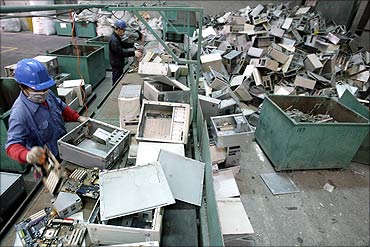
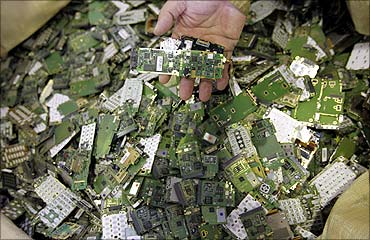

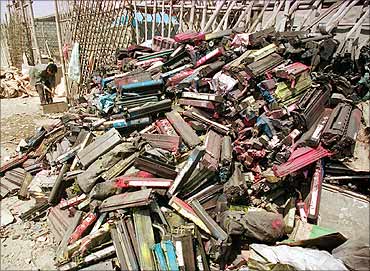
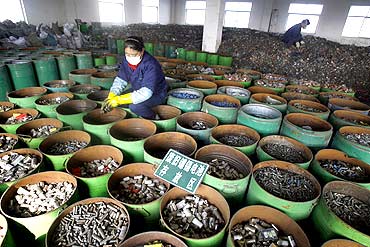
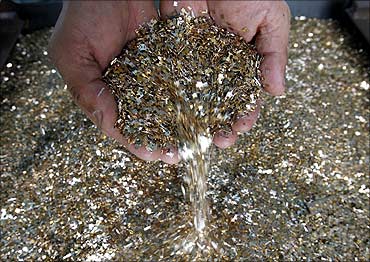
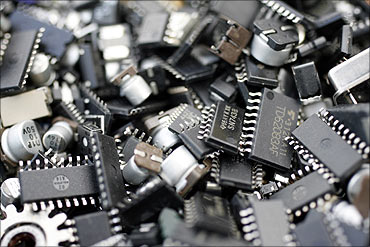

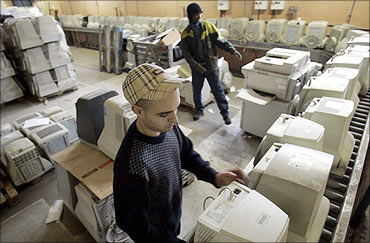
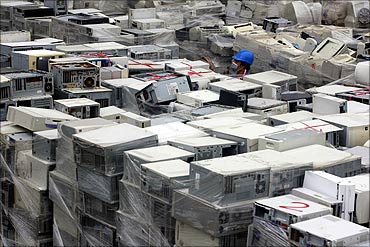

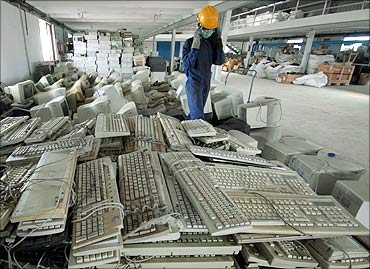
article